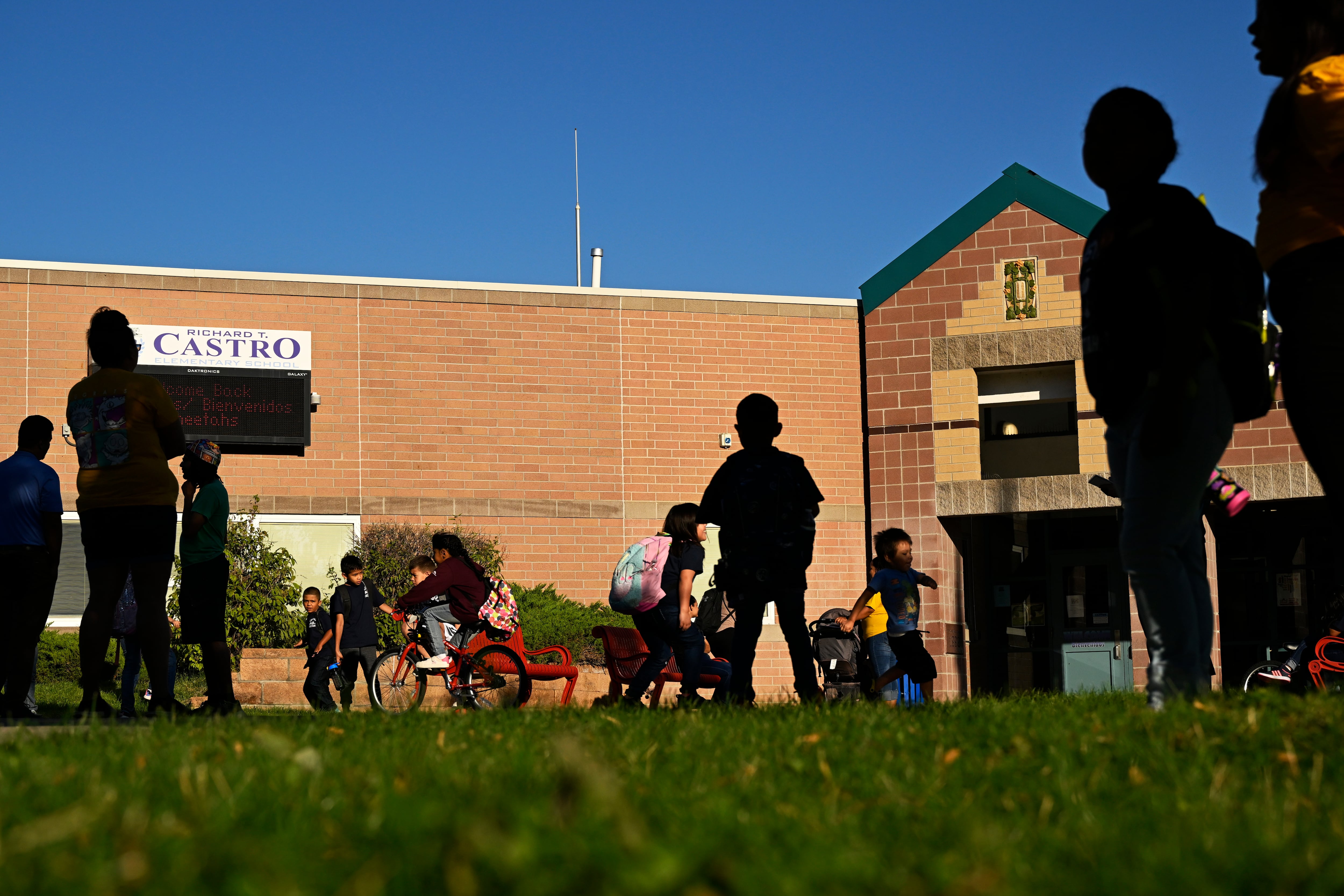Sign up for Chalkbeat Colorado’s free daily newsletter to get the latest reporting from us, plus curated news from other Colorado outlets, delivered to your inbox.
Ten Denver schools will close or partially close after the school board voted unanimously Thursday to approve a plan to address declining enrollment.
Seven schools will close at the end of the school year:
- Castro Elementary
- Columbian Elementary
- Denver School of Innovation and Sustainable Design
- International Academy of Denver at Harrington
- Palmer Elementary
- Schmitt Elementary
- West Middle School
Three schools will partially close:
- Kunsmiller Creative Arts Academy will lose its elementary school grades.
- Dora Moore ECE-8 school will lose its middle school grades.
- Denver Center for International Studies will lose its high school grades.
After the vote, several people in the audience shouted, “Shame on you!”
Thursday’s vote came two weeks after Superintendent Alex Marrero publicly announced the closure recommendation, a tight timeline that drew criticism from some parents, advocacy groups, and elected officials.
The past two weeks were filled with intense community pushback against the plan, student walkouts, and even threats of legal action. Families and teachers repeatedly described their small schools as tight-knit and effective communities.
But several board members said closures are necessary because of the financial strain of operating schools with low enrollment. The district is providing more than $3.8 million in subsidies to the 10 schools this year, a situation board member John Youngquist called “inequitable, unaffordable, and unsustainable.”
Because Denver funds its schools per student, schools with lower enrollment have less money to pay for staff and programming. Board members said that too is inequitable, and that closing small schools will allow students to go to larger, better resourced schools.
“These students will receive more of the resources that they deserve to have to be successful,” board member Marlene De La Rosa said, “and to build that strong foundation so they can reach their potential, so they can have opportunity.”
Board member Scott Esserman called the vote “an impossibly hard decision” that the board had to make because previous leaders “weren’t courageous enough to make the hard decisions.”
Member Xóchitl “Sochi” Gaytán pointed to both gentrification and charter schools “siphoning away children” as reasons for declining enrollment in Denver’s district-run schools.
All board members thanked students, families, and teachers for their input.
“I am truly grateful for everyone’s honesty and engagement,” board member Michelle Quattlebaum said. “Please know that I see you, I heard you, I will continue to see you, I will continue to hear you, and I do recognize the humanity.”
The closures will eliminate nearly 4,000 vacant seats in the 10 schools and save the district $6.6 million in the 2025-26 school year, district officials have said.
The changes will directly affect 1,087 students, according to a district presentation, which is a little more than 1% of the district’s approximately 90,000 students. Students of color and those from low-income families are disproportionately impacted; seven of the 10 schools serve a higher percentage of students of color than the district average.
Enrollment in Denver Public Schools peaked in 2019 and steadily declined until 2023, when an influx of migrant students boosted the numbers. Enrollment is up again this year for the same reason, but district officials said it’s not enough to stave off the need to close schools. They predict enrollment will fall another 9% by the 2028-29 school year due to low birth rates and high housing prices that push families out of the city.
The school board rejected a previous attempt by Marrero in 2022 to close 10 schools due to declining enrollment because members said the district hadn’t done enough to engage the community about the proposed closures. However, a few months later, the board agreed to close three of those schools at the end of the 2022-23 school year.
Earlier this year, the board adopted a new school closure policy called Executive Limitation 18. Using that policy, Marrero looked at several criteria to identify schools for closure, including the school’s student count, whether it was located in an area with declining enrollment, its popularity with neighborhood families, and its academic performance.
Esserman proposed an amendment to the school closure policy Thursday that would have put a three-year moratorium on future school closures. It failed to get majority support from the board.
What happens next?
What will happen to the students will largely be up to individual families. Marrero’s plan is to reassign most students at the closed schools to new or expanded enrollment zones. Enrollment zones are large boundaries that contain several schools from which families can choose.
However, students don’t have to abide by that. Under the state’s school choice law, they can apply to any school in the district — and district officials have promised them first priority. About 42% of Denver students use school choice.
If students do follow Marrero’s plan, here’s what will happen at each school:
Castro Elementary, which serves 237 students this year.
Students will be reassigned to one of two nearby schools: Knapp Elementary or CMS Community School. Students who live north of West Kentucky Avenue will be reassigned to Knapp, and students who live south will be reassigned to CMS.
Columbian Elementary, which serves 143 students this year.
Students will be part of a new enrollment zone in northwest Denver. The zone will include Beach Court Elementary, Edison Elementary, Trevista at Horace Mann, and Centennial: A School for Expeditionary Learning. A special education program at Columbian will move to Trevista.
Denver School of Innovation and Sustainable Design, which serves 60 students this year.
Because DSISD is an all-choice school and does not have a boundary, its students will not be reassigned to a specific school. Instead, they will be guaranteed a seat at their boundary school or a school in the enrollment zone where they live.
International Academy of Denver at Harrington, which serves 122 students this year.
Students will be part of an enrollment zone in central Denver that will be expanded to include three more schools. The zone will include Swansea Elementary, Garden Place Academy, Wyatt Academy, Columbine Elementary, Cole Arts and Science Academy, Whittier ECE-8 School, and University Prep - Arapahoe Street. A special education program at IAD at Harrington will move to Garden Place Academy.
Palmer Elementary, which serves 150 students this year.
Students will be part of a new enrollment zone in central-east Denver. The zone will include Teller Elementary, Steck Elementary, Carson Elementary, Montclair School of Academics and Enrichment, Lowry Elementary, and Denver Green School Southeast. The district is still deciding where to relocate a preschool program at Palmer that serves students with disabilities.
Schmitt Elementary, which serves 127 students this year.
Students will be part of a new enrollment zone in southwest Denver. The zone will include Godsman, McKinley-Thatcher, and Asbury elementary schools.
West Middle School, which serves 186 students this year.
Students will be guaranteed a seat at any school in the existing enrollment zone. District officials hope many West Middle students will enroll at Denver Center for International Studies, located just a half mile away, which will become a middle school.
Denver Center for International Studies, which serves 210 high school students this year.
DCIS Baker, as it’s known, will lose its high school grades and become a middle school only. DCIS Baker high school students will have a seat at West High School, located just a half mile away. DCIS Baker’s programming will move to West High, as will a special education program. The new DCIS middle school will become part of an existing enrollment zone in west Denver. Marrero said Thursday that DCIS middle school will establish a dual language program.
Dora Moore ECE-8 School, which serves 62 middle school students this year.
Dora Moore will lose its middle school grades and become an elementary school only. Because its middle school is an all-choice school and does not have a boundary, students will not be reassigned to a specific school. Instead, they will be guaranteed a seat at their boundary school or a school in the enrollment zone where they live. District officials hope many Dora Moore students will enroll at Morey Middle School, which is less than a mile away. Morey currently shares its building with DSISD, the closure of which will create more space at Morey.
Kunsmiller Creative Arts Academy, which serves 128 elementary school students this year.
Kunsmiller will lose its elementary school grades and become a middle and high school only. Because Kunsmiller is an all-choice school and does not have a boundary, its students will not be reassigned to a specific school. Instead, they will be guaranteed a seat at their boundary school or a school in the enrollment zone where they live.
Marrero has repeatedly said that school bus transportation will be guaranteed for all students who live in enrollment zones, not just students from the closed schools. The district provides transportation to elementary students who live more than a mile from their zone school, and to middle and high school students who live more than 2½ miles away.
The Denver teachers union has asked the district to negotiate a special agreement that would provide job protections to the teachers at the closing schools.
As it stands now, teachers who have earned Colorado’s version of tenure and are unable to find another job on their own will be guaranteed a one-year position next school year.
Non-tenured teachers will be offered a yearlong position if they teach special education, middle or high school math, or are bilingual and work with Spanish-speaking students who are learning English. All other non-tenured teachers will only be offered a one-year position if they enroll in programs to become certified to work in those hard-to-fill roles.
Melanie Asmar is the bureau chief for Chalkbeat Colorado. Contact Melanie at masmar@chalkbeat.org.






